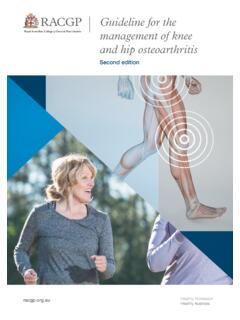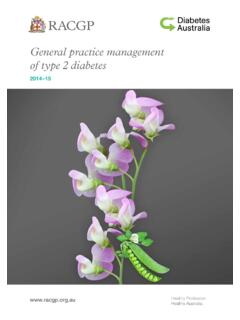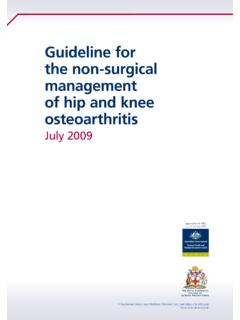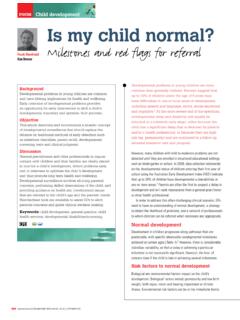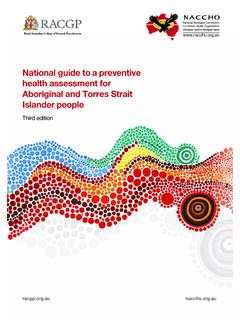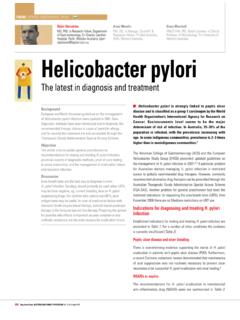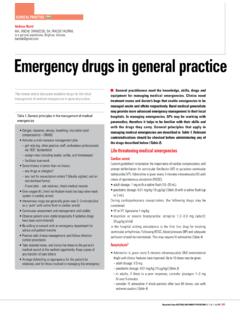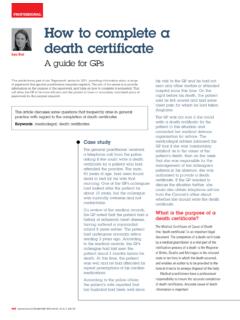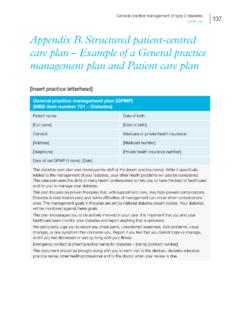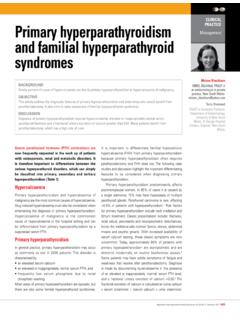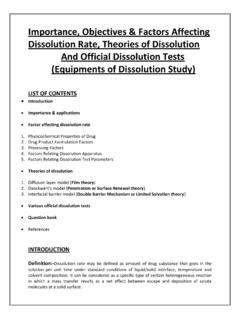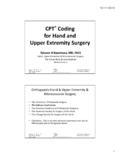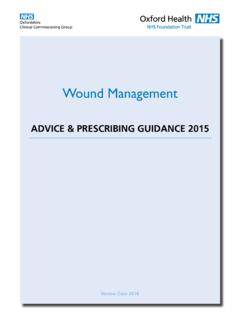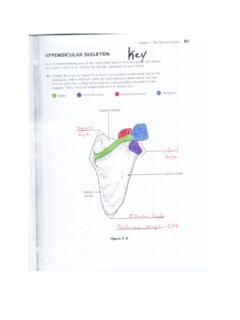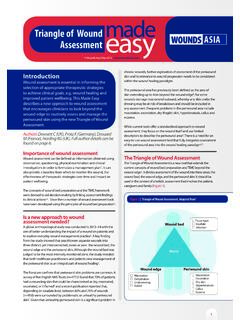Transcription of Wounds Which dressing should I use?
1 486 Reprinted from Australian Family Physician Vol. 35, No. 7, July 2006 Keryln Carville RN, PhD, is Associate Professor Domiciliary Nursing, Silver Chain Nursing Association and Curtin University of Technology, Western Australia. management is more than the application of a dressing . It requires a comprehensive and informed approach to the assessment of the patient, their wound and their healing environmentOBJECTIVEThis article outlines a systematic approach to guide assessment and management of chronic international advisory panel has developed a framework for assessment and management of chronic Wounds , known as wound bed preparation.
2 The steps in this framework include tissue assessment and the management of nonviable tissue or tissue deficits, inflammation and infection control, maintenance of moisture balance, and the promotion of epithelial advancement of wound edges. The acronym TIME is a useful aid for these steps. In addition, good wound care involves assessment of the surrounding skin and wound dimensions, and documentation of the wound healing process and treatments used. dressing choice depends on this assessment and the characteristics of the wound. Goals of care include the need to consider the patient, their wound and their healing management is more than the application of a dressing .
3 It requires a comprehensive and informed approach to the assessment of the patient, their wound, and their healing environment. The challenge for the general practitioner is how best to keep abreast of the increasing body of research that informs best practice, and the technological advances that expedite optimal healing outcomes. In 1993, there were estimated to be over 2000 wound dressings on the Today we have a plethora of wound dressings, pharmaceuticals and devices from Which to choose.
4 The problem is, what dressings should we choose? A systematic approach, known as wound bed preparation, has been developed by an international advisory panel to guide assessment and management of chronic The acronym TIME can be used to outline individual steps within this framework: Tissue assessment and the management of nonviable tissue or tissue deficits Inflammation and Infection control maintenance of Moisture balance, and the promotion of epithelial advancement of wound Edges (Table 1).
5 3,4 Tissue managementWound debridement is performed when assessment reveals the presence of nonviable tissue (Figure 1). Surgical sharp debridement is usually employed for removal of extensive tissue necrosis or infection in acute Wounds . Regular debridement of necrotic or infected tissue and excessive proteases has been demonstrated to be beneficial in chronic wound In addition to sharp debridement, dressings that promote autolytic and nontoxic chemical debridement are available (Table 2).
6 In Australia, there is an increasing interest in the use of larval therapy for debridement. S t e r i l e L u c i l i a s e r i c a t a ( G r e e n b o tt l e f l y ) l a r va e are being produced at Westmead Hospital in Sydney, New South Wales, for this and inflammation controlClassic signs and symptoms of inflammation were noted by Celsus in the first century as: tumour (swelling), rubor Which dressing should I use? It all depends on the TIMEING THEME WoundsReprinted from Australian Family Physician Vol.
7 35, No. 7, July 2006 487(erythema), calor (heat) and dolor (pain). Inflammation can occur as a normal response to wound healing. It can also occur in response to wound infection with the added sign of purulent or increased malodorous exudate (Figure 2). Contamination, Which is defined as the presence of nonreplicating bacteria in a wound, does not inhibit wound However, tissue hypoxia or necrosis is conducive to colonisation, Which is defined as the presence of replicating bacteria but with no host Skin commensals such as Staphylococcus e p i d e r m i s a n d C o r y n e b a c t e r i u m f l o r a a r e t o b e expected in the wound and have been found at low levels to have a positive effect on Critical colonisation or covert infection is defined as an increase in the bacterial burden of the wound.
8 In critically colonised w o u n d s t h e p r o - i n f l a m m a t o r y c y t o k i n e s a n d matrixmet alloproteases (MMPs) alter the wound environment and healing is ,7 Critically colonised Wounds do not portray the classic signs of infection, although the wound may demonstrate one or more of the following signs: static healing increased exudate pale grey or deep red granulation tissue friable granulation tissue that bleeds easily hypergranulation tissue bridging, and rolled edges.
9 The prudent use of topical antiseptic dressings at this stage can restore the bacterial balance in the wound and may eliminate the need for systemic antibiotics. Because bacterial imbalance usually results in increased amounts of wound exudate, maintenance of moisture balance, as outlined below, is an associated goal. Examples of antimicrobial dressings available for restoration of bacterial balance are outlined in Table moisture balancedesiccation of the wound inhibits epithelialisation and excessive moisture leads to maceration and further breakdown of tissue (Figure 3).
10 It has been reported that chronic wound fluid contains increased levels of MMPs, Which have the potential to degrade much needed extracellular matrix proteins such as fibronectin a n d v i t r o n e c t i n .8 I t h a s a l s o b e e n p r o p o s e d that excessive fluid in chronic Wounds can interfere with the activities of important cell mediators such as growth The goal is to maintain moisture balance and dressing selection will be influenced by t h e n e e d t o hyd r a t e t h e wo u n d b e d o r a b s o r b excessive fluids (Table 4).
